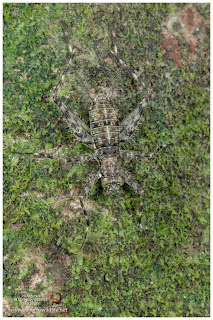We had macro photography in oblivion so we have returned to this type of photography on the last weeks. We made some nocturnal tours, on which we were able to make the following pictures.
Horned Scarabs (Scarabaeoidea) are diverse with around 35,000 species placed in this superfamily and some 200 new species are described each year.
Orb-weaver Spider
Assassin Bug (Salyavata variegata) fishes for termites by dangling a dead termite from its beak; when another termite comes to inspect the cadaver, the bug grabs a fresh victim.
Assassin Bug nymph (Reduviidae)
Assassin bugs are predators possessing an elongated head, they also usually have a stout beak that ensheathes the lance-like mouthparts that are used to stab prey, inject it with salivary enzymes, and suck up the liquefied contents. Although most are food generalists, some species of assassin bug show certain preferences as Salyavata variegata above.
Cockroaches (Blattodea) inhabit leaf litter, rotting wood, forest canopy, and even the nests of leafcutter ants.
Wasp Mimic Moth (Sesiidae)
The Sesiidae family of moths are notorious for their ability to mimic wasps. Through physical and behavior mimicry, they gain protection by an association with another insect.
Flowers
Orb Weaver Spider (Eriophora sp.). Generally dull brown, sometimes with white or yellow "shoulders" on the abdomen, and alternate color forms. These spiders spin their webs, which can be many feet wide, in the evening. At night they sit in the web. By day, they will usually hide in a rolled-up leaf somewhere near the edge of the web.
Harvestman or Daddy Longlegs (Opiliones)
Leafhopper (Cicadellidae)
Broad-nosed Weevil (Curculionoidea). Most especies are medium sized and many are brightly colored due to scales that cover their bodies and often seen on plant foliage.
Planthopper (Flatidae). Flatidae is a family of fulgoroid planthoppers. They are cosmopolitan in distribution. In the subfamily Flatinae, the body of adults is flattened laterally and the tegmina are tent-like. In the Flatoidinae, the body is not laterally compressed and the tegmina are not as tent-like and sometimes held horizontally.
Planthopper nymph (Flatidae) covered with wax secretions.
Katydid (Tettigoniidae). Primarily nocturnal in habit, with strident mating calls, many katydids exhibit
mimicry and
camouflage.
Bark Mantises (Liturgusa sp.) live on the bark of trees, especially those with smooth bark.
Anole lizard (Anolis sp.)


























Comments
Post a Comment